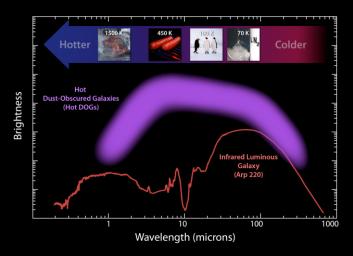This plot illustrates the new population of "hot DOGs," or hot dust-obscured objects, found by WISE. The purple band represents the range of brightness observed for the extremely dusty objects. These powerful galaxies, which host active supermassive black holes at their cores, pour out enormous amounts of light at infrared wavelengths, while their visible light is blocked by dust.
Visible light we see with our eyes has shorter wavelengths than one micron, while the longest wavelengths shown here come from observations with the Caltech Submillimeter Observatory on Mauna Kea, Hawaii. The red line shows the brightness profile, or spectral energy distribution, of a proto-typical infrared luminous galaxy.
The small images near the top show more familiar objects at a range of temperatures from 70 Kelvin, or minus 330 degrees Fahrenheit, for liquid nitrogen, to 1,500 Kelvin, or 2,240 degrees Fahrenheit, for lava. The energy from hotter objects peaks at shorter wavelengths.
The extreme WISE objects represented by the purple band are much brighter -- and peak at much shorter, or hotter, wavelengths -- than the typical infrared luminous galaxy, hence their nickname: hot dust-obscured galaxies or Hot DOGs.
NASA's Jet Propulsion Laboratory, Pasadena, Calif., manages, and operated WISE for NASA's Science Mission Directorate. The spacecraft was put into hibernation mode after it scanned the entire sky twice, completing its main objectives. Edward Wright is the principal investigator and is at UCLA. The mission was selected competitively under NASA's Explorers Program managed by the agency's Goddard Space Flight Center in Greenbelt, Md. The science instrument was built by the Space Dynamics Laboratory in Logan, Utah. The spacecraft was built by Ball Aerospace & Technologies Corp. in Boulder, Colo. Science operations and data processing take place at the Infrared Processing and Analysis Center at the California Institute of Technology in Pasadena. Caltech manages JPL for NASA.
More information is online at http://www.nasa.gov/wise and http://wise.astro.ucla.edu.

 Planetary Data System
Planetary Data System












